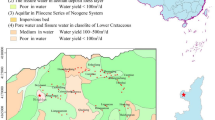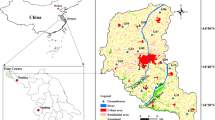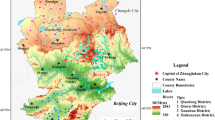Abstract
The present study investigated ion and fluoride concentrations in groundwater and their associated health risks to local populations in the southern Hebei Plain during 2018–2020. A total of 336 groundwater samples were collected from monitoring wells at 112 different locations. Statistical analysis, Gibbs diagram, principal ion ratio, and saturation index were carried out to clarify the chemical characteristics and control mechanism of groundwater. The results indicated that the groundwater types in the study area were mainly HCO3–Ca, Cl–Na, and SO4–Ca. The concentrations of cations and anions were Na+ > Ca2+ > Mg2+ > K+ and HCO3− > SO42− > Cl− > NO3− > F−, respectively. Based on the water chemical parameters, the pollution index of groundwater (PIG) was used to comprehensively evaluate the water quality. The results showed that during the study period, 60.41% of groundwater samples were suitable for drinking purposes, and 39.59% needed purification treatment to meet the requirements of drinking water standards. The groundwater quality in the western pre-hill plain areas was good, while the water quality in the northeastern and southeastern areas was poor and contaminated to varying degrees. Groundwater quality was mainly affected by the combined effect of total dissolved solids (TDS), Na+, Mg2+, Cl−, SO42− and HCO3− concentrations. Fluoride concentrations in the groundwater samples ranged from 0.07 to 8.51 mg/L, with 44% of the samples containing fluoride below the recommended limit of 0.5 mg/L, which would put the population at risk of dental caries. Also, 8% of the samples exceeded the permissible limit for fluoride in drinking water (1.5 mg/L), which would expose the local population to the risk of fluorosis. The human health risk evaluation of fluoride showed significant differences in non-carcinogenic effects between two different groups of children and adults. HIin values ranged from 0.08 to 10.19 for children and 0.03 to 4.65 for adults, with hazard indices greater than 1 at 29.16% and 10.11%, respectively. This indicates that children have a greater exposure risk than adults, and the entropy of higher risk is mainly distributed in the northeast of the study area. Based on the above analysis of the spatial evolution of groundwater chemistry, water quality, and fluoride health risks in the southern Hebei Plain region, corresponding protection and management measures were proposed, which also provided reference significance for the effective use of drinking water and health risk prevention in the region.











Similar content being viewed by others
Data availability
The datasets used or analyzed during the current study are available from the corresponding author on reasonable request.
References
Adimalla N (2021) Application of the entropy weighted water quality index (EWQI) and the pollution index of groundwater (PIG) to assess groundwater quality for drinking purposes: a case study in a rural area of Telangana state, India. Arch Environ Contam Toxicol 80(1):31–40. https://doi.org/10.1007/s00244-020-00800-4
Ahmed MA, Abdel Samie SG, Badawy HA (2012) Factors controlling mechanisms of groundwater salinization and hydrogeochemical processes in the quaternary aquifer of the eastern nile delta, egypt. Environ Earth Sci 68(2):369–394. https://doi.org/10.1007/s12665-012-1744-6
Ali S, Thakur SK, Sarkar A, Shekhar S (2016) Worldwide contamination of water by fluoride. Environ Chem Lett 14(3):291–315. https://doi.org/10.1007/s10311-016-0563-5
Brahman KD, Kazi TG, Baig JA, Afridi HI, Khan A, Arain SS, Arain MB (2014) Fluoride and arsenic exposure through water and grain crops in Nagarparkar, Pakistan. Chemosphere 100:182–189. https://doi.org/10.1016/j.chemosphere.2013.11.035
Chen S, Tang Z, Wang J, Wu J, Yang C, Kang W, Huang X (2020) Multivariate analysis and geochemical signatures of shallow groundwater in the main urban area of Chongqing, Southwestern China. Water 12(10). https://doi.org/10.3390/w12102833
China National Standardization Administration Committee (2009) Methods for examination of drinking natural mineral water (GB8538-2008). Bei**g, China (in Chinese)
Dehbandi R, Moore F, Keshavarzi B (2018) Geochemical sources, hydrogeochemical behavior, and health risk assessment of fluoride in an endemic fluorosis area, Central Iran. Chemosphere 193:763–776. https://doi.org/10.1016/j.chemosphere.2017.11.021
Emenike CP, Tenebe IT, Jarvis P (2018) Fluoride contamination in groundwater sources in Southwestern Nigeria: assessment using multivariate statistical approach and human health risk. Ecotoxicol Environ Saf 156:391–402. https://doi.org/10.1016/j.ecoenv.2018.03.022
Farid I, Zouari K, Rigane A, Beji R (2015) Origin of the groundwater salinity and geochemical processes in detrital and carbonate aquifers: case of Chougafiya Basin (central Tunisia). J Hydrol 530:508–532. https://doi.org/10.1016/j.jhydrol.2015.10.009
Gibbs RJ (1970) Mechanisms controlling world water chemistry. Science 170:1088–1090
Gu X, **ao Y, Yin S, Hao Q, Liu H, Hao Z, Meng G, Pei Q, Yan H (2018) Hydrogeochemical characterization and quality assessment of groundwater in a long-term reclaimed water irrigation area, north china plain. Water 10(9). https://doi.org/10.3390/w10091209
Jia H, Qian H, Qu W, Zheng L, Feng W, Ren W (2019) Fluoride occurrence and human health risk in drinking water wells from southern edge of Chinese loess plateau. Int J Environ Res Public Health 16(10). https://doi.org/10.3390/ijerph16101683
Karunanidhi D, Aravinthasamy P, Subramani T, Roy PD, Srinivasamoorthy K (2019) Risk of fluoride rich groundwater on human health: remediation through managed aquifer recharge in a hard rock terrain, south india. Nat Resources Res 29(4):2369–2395. https://doi.org/10.1007/s11053-019-09592-4
Latchmore T, Hynds P, Brown RS, Schuster-Wallace C, Dickson-Anderson S, McDermott K, Majury A (2020) Analysis of a large spatiotemporal groundwater quality dataset, ontario 2010-2017: informing human health risk assessment and testing guidance for private drinking water wells. Sci Total Environ 738:140382. https://doi.org/10.1016/j.scitotenv.2020.140382
Li H, Liu Q, Wang W, Yang L, Li Y, Feng F, Zhao XY, Hou K, Wang G (2009) Fluoride in drinking water, brick tea infusion and human urine in two counties in inner mongolia, china. J Hazard Mater 167(1–3):892–895. https://doi.org/10.1016/j.jhazmat.2009.01.094
Li P, Wu J, Qian H (2012) Assessment of groundwater quality for irrigation purposes and identification of hydrogeochemical evolution mechanisms in pengyang county, china. Environ Earth Sci 69(7):2211–2225. https://doi.org/10.1007/s12665-012-2049-5
Li P, Tian R, Xue C, Wu J (2017) Progress, opportunities, and key fields for groundwater quality research under the impacts of human activities in China with a special focus on Western China. Environ Sci Pollut Res Int 24(15):13224–13234. https://doi.org/10.1007/s11356-017-8753-7
Li X, Huang X, Zhang Y (2021) Spatio-temporal analysis of groundwater chemistry, quality and potential human health risks in the **gu Basin of North China Plain: evidence from high resolution monitoring dataset of 2015-2017. Sci Total Environ 800:149568. https://doi.org/10.1016/j.scitotenv.2021.149568
Li J, Shi Z, Wang G, Liu F (2020) Evaluating spatiotemporal variations of groundwater quality in Northeast Bei**g by self-organizing map. Water 12(5). https://doi.org/10.3390/w12051382
Liu T, Gao X, Zhang X, Li C (2019) Distribution and assessment of hydrogeochemical processes of F-rich groundwater using PCA model: a case study in the Yuncheng Basin. China Acta Geochim 39(2):216–225. https://doi.org/10.1007/s11631-019-00374-6
Luo Y, **ao Y, Hao Q, Zhang Y, Zhao Z, Wang S, Dong G (2021) Groundwater geochemical signatures and implication for sustainable development in a typical endorheic watershed on Tibetan Plateau. Environ Sci Pollut Res Int 28(35):48312–48329. https://doi.org/10.1007/s11356-021-14018-x
Mao M, Guo P, Zhu X, Yang J, Pan D (2021) Hydrochemical characterization and quality assessment of groundwater in the hilly area of the Taihang Mountains in Henan Province, China. Environ Sci Pollut Res Int 28(32):43853–43871. https://doi.org/10.1007/s11356-021-13579-1
Meng Q, Zhang J, Zhang Z, Wu T (2016) Geochemistry of dissolved trace elements and heavy metals in the Dan River Drainage (China): distribution, sources, and water quality assessment. Environ Sci Pollut Res Int 23(8):8091–8103. https://doi.org/10.1007/s11356-016-6074-x
MEPRC (Ministry of Evironmental Protection of the People’s Republic of China) (2015) Inductively coupled plasma optical emission spectrometry (HJ-776-2015). Bei**g, China (in Chinese)
MHPRC (Ministry of Health of the People’s Republic of China) (2006) Standards for drinking water quality (GB 5749-2006). Bei**g, China (in Chinese)
Mihai S, Lundberg J, McFarlane DA, Chandler B (2010) Pengelly’s legacy reconsidered: a GIS approach to spatial analysis of palaeontological and archaeological collections from Kents Cavern, England. Proc Geol Assoc 121(3):319–325. https://doi.org/10.1016/j.pgeola.2010.07.003
Mousazadeh H, MahmudyGharaie MH, Mosaedi A, MoussaviHarami R (2019) Hydrochemical assessment of surface and ground waters used for drinking and irrigation in Kardeh Dam Basin (NE Iran). Environ Geochem Health 41(3):1235–1250. https://doi.org/10.1007/s10653-018-0214-9
NHFPC and (CFDA), CFADA (2009) National food safety standards inspection methods of drinking natural mineral water (GB8538–2008). Standards Press of China, Bei**g
Peng C, He J, Wang M, Zhang Z, Wang L (2018) Identifying and assessing human activity impacts on groundwater quality through hydrogeochemical anomalies and NO3(-), NH4(+), and COD contamination: a case study of the Liujiang River Basin, Hebei Province, People’s Republic of China. Environ Sci Pollut Res Int 25(4):3539–3556. https://doi.org/10.1007/s11356-017-0497-x
Plummer R, Loë RD, Armitage D (2012) A systematic review of water vulnerability assessment tools. Water Resour Manage 26(15):4327–4346. https://doi.org/10.1007/s11269-012-0147-5
Rao NS, Sunitha B, Rambabu R, Rao Nageswara PV, Rao PS, Spandana BD, Sravanthi M, Marghade D (2018) Quality and degree of pollution of groundwater, using PIG from a rural part of Telangana State, India. Appl Water Sci 8(8). https://doi.org/10.1007/s13201-018-0864-x
Rashid A, Khan S, Ayub M, Sardar T, Jehan S, Zahir S, Khan MS, Muhammad J, Khan R, Ali A, Ullah H (2019) Map** human health risk from exposure to potential toxic metal contamination in groundwater of Lower Dir, Pakistan: application of multivariate and geographical information system. Chemosphere 225:785–795. https://doi.org/10.1016/j.chemosphere.2019.03.066
Rasool A, **ao T, Farooqi A, Shafeeque M, Masood S, Ali S, Fahad S, Nasim W (2016) Arsenic and heavy metal contaminations in the tube well water of Punjab, Pakistan and risk assessment: a case study. Ecol Eng 95:90–100. https://doi.org/10.1016/j.ecoleng.2016.06.034
Subba Rao N (2012) PIG: a numerical index for dissemination of groundwater contamination zones. Hydrol Process 26(22):3344–3350. https://doi.org/10.1002/hyp.8456
Supervision, GAoQ (2017) Standards for groundwater quality (GB/T 14848-2017). Standards Press of China Bei**g (in Chinese)
US EPA (2011) User’s guide: human health risk assessment. United States Environmental Protection Agency, Washington, DC
USEPA (1989) Risk assessment guidance for superfund volume I: human health evaluation manual (part A). Office of Emergency and Remedial Response, Washington, D.C. 540(2): 1–89
Vithanage M, Bhattacharya P (2015) Fluoride in the environment: sources, distribution and defluoridation. Environ Chem Lett 13(2):131–147. https://doi.org/10.1007/s10311-015-0496-4
Wang H, Wang H, Li C, Mu Z (2017a) Distribution of water chemical types and causes of pollutants in Handan groundwater. J Hebei Univ Eng (Natural Science Edition) 34(1):53–56 In Chinese
Wang J, Liu G, Liu H, Lam Paul KS (2017b) Multivariate statistical evaluation of dissolved trace elements and a water quality assessment in the middle reaches of Huaihe River, Anhui, China. Sci Total Environ 583:421–431. https://doi.org/10.1016/j.scitotenv.2017.01.088
Wei C, Guo H, Zhang D, Wu Y, Han S, An Y, Zhang F (2016) Occurrence and hydrogeochemical characteristics of high-fluoride groundwater in **ji County, southern part of Ningxia Province, Chian. Environ Geochem Health 38(1):275–290. https://doi.org/10.1007/s10653-015-9716-x
WHO (2008) Guidelines for drinking-water quality. World Health Organization, Geneva
WHO (2011) Guideline for drinking water quality, 4th edn. World Health Organization, Geneva
Wu B, Zhao D, Jia H, Zhang Y, Zhang X, Cheng S (2009) Preliminary risk assessment of trace metal pollution in surface water from Yangtze River in Nan**g Section, Chian. Bull Environ Contam Toxicol 82(4):405–409. https://doi.org/10.1007/s00128-008-9497-3
Wu B, Zhang Y, Zhang X, Cheng S (2011) Health risk assessment of polycyclic aromatic hydrocarbons in the source water and drinking water of China: quantitative analysis based on published monitoring data. Sci Total Environ 410–411:112–118. https://doi.org/10.1016/j.scitotenv.2011.09.046
**ao Y, Gu X, Yin S, Pan X, Shao J, Cui Y (2017) Investigation of geochemical characteristics and controlling processes of groundwater in a typical long-term reclaimed water use area. Water 9(10):800. https://doi.org/10.3390/w9100800
Xu S, Liu X (2011) Distribution status and cause analysis of high fluoride groundwater in Handan City. Groundwater 33(2):28–29 In Chinese
Yin S, **ao Y, Han P, Hao Q, Gu X, Men B, Huang L (2020) Investigation of groundwater contamination and health implications in a typical semiarid basin of North China. Water 12(4). https://doi.org/10.3390/w12041137
Yue W, Meng K, Hou K, Zuo R, Zhang B, Wang G (2020) Evaluating climate and irrigation effects on spatiotemporal variabilities of regional groundwater in an arid area using EOFs. Sci Total Environ 709:136147. https://doi.org/10.1016/j.scitotenv.2019.136147
Zeng X, Liu Y, You S, Zeng G, Tan X, Hu X, Hu X, Huang L, Li F (2015) Spatial distribution, health risk assessment and statistical source identification of the trace elements in surface water from the **angjiang River, China. Environ Sci Pollut Res Int 22(12):9400–9412. https://doi.org/10.1007/s11356-014-4064-4
Zhan Y, Guo H, Wang Y, Li R, Hou C, Shao J, Cui Y (2014) Evolution of groundwater major components in the Hebei Plain: evidences from 30-year monitoring data. J Earth Sci 25(3):563–574. https://doi.org/10.1007/s12583-014-0445-3
Zhang L, Huang D, Yang J, Wei X, Qin J, Ou S, Zhang Z, Zou Y (2017) Probabilistic risk assessment of Chinese residents’ exposure to fluoride in improved drinking water in endemic fluorosis areas. Environ Pollut 222:118–125. https://doi.org/10.1016/j.envpol.2016.12.074
Zhang Y, Wu J, Xu B (2018) Human health risk assessment of groundwater nitrogen pollution in **ghui canal irrigation area of the loess region, Northwest China. Environ Earth Sci 77(7):273–284. https://doi.org/10.1007/s12665-018-7456-9
Zhi C, Chen H, Li P, Ma C, Zhang J, Zhang, C, Wang C, Yue X (2019) Spatial distribution of arsenic along groundwater flow path in Chaobai River alluvial–proluvial fan, North China Plain. Environ Earth Sci 78(8):. https://doi.org/10.1007/s12665-019-8260-x
Acknowledgements
We acknowledge the financial support provided by the Hebei Provincial Key R&D Program (21373901D). We are also particularly grateful to the laboratory of the Hebei Geological and Environmental Monitoring Institute for their help in testing the samples.
Funding
This research was supported by the Hebei Provincial Key R&D Program (21373901D).
Author information
Authors and Affiliations
Contributions
All authors contributed to the study conception and design. Longqiang Zhang: data curation, writing—original draft and editing. Donglin Dong: project administration, conceptualization, methodology, funding acquisition, and supervision. Situ Lv: data analysis. Jia Ding: software and investigation. Maohua Yan: data collection. Guilei Han: study area survey. All authors read and approved the final manuscript.
Corresponding author
Ethics declarations
Ethics approval and consent to participate
Not applicable.
Consent for publication
Not applicable.
Conflict of interest
The authors declare no competing interests.
Additional information
Responsible Editor: **anliang Yi
Publisher's note
Springer Nature remains neutral with regard to jurisdictional claims in published maps and institutional affiliations.
Rights and permissions
Springer Nature or its licensor (e.g. a society or other partner) holds exclusive rights to this article under a publishing agreement with the author(s) or other rightsholder(s); author self-archiving of the accepted manuscript version of this article is solely governed by the terms of such publishing agreement and applicable law.
About this article
Cite this article
Zhang, L., Dong, D., Lv, S. et al. Spatial evolution analysis of groundwater chemistry, quality, and fluoride health risk in southern Hebei Plain, China. Environ Sci Pollut Res 30, 61032–61051 (2023). https://doi.org/10.1007/s11356-023-26316-7
Received:
Accepted:
Published:
Issue Date:
DOI: https://doi.org/10.1007/s11356-023-26316-7




